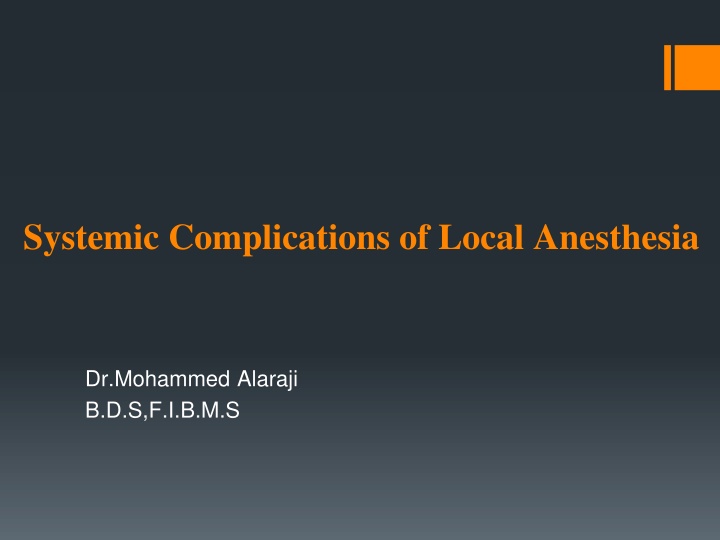
Systemic Complications of Local Anesthesia in Dentistry
Learn about systemic complications like fainting, hypersensitivity, overdosage, and drug interactions associated with local anesthesia in dentistry. Discover predisposing factors, prevention strategies, and management techniques for these issues.
Download Presentation

Please find below an Image/Link to download the presentation.
The content on the website is provided AS IS for your information and personal use only. It may not be sold, licensed, or shared on other websites without obtaining consent from the author. If you encounter any issues during the download, it is possible that the publisher has removed the file from their server.
You are allowed to download the files provided on this website for personal or commercial use, subject to the condition that they are used lawfully. All files are the property of their respective owners.
The content on the website is provided AS IS for your information and personal use only. It may not be sold, licensed, or shared on other websites without obtaining consent from the author.
E N D
Presentation Transcript
Systemic Complications of Local Anesthesia Dr.Mohammed Alaraji B.D.S,F.I.B.M.S
A. Fainting (vasovagal attack) B. Hypersensitivity or allergy to local anesthesia C. Overdosage and toxicity D. Drug interaction
Fainting (Vasovagal Attack) It is the most common systemic complication that occurs with local anesthesia in the dental office. It refers to a sudden transient loss of consciousness usually secondary to cerebral ischemia. The cerebral ischemia is secondary to vasodilatation or an increase in peripheral vascular bed, with a corresponding drop in blood pressure. The collapse in the dental chair may occur suddenly and may not be accompanied by loss of consciousness, in most instances, these episodes are vasovagal attack and spontaneous recovery is usual. The patient often complains of feeling dizzy, weak, and nauseated, the skin is pale, cold and slow pulse is noticed.
Predisposing Factors or Triggering Stimulus The predisposing factors for this condition may be divided into two groups: 1) Psychogenic factors: A. Anxiety B. Emotional stress C. Pain of sudden and unexpected nature D. The sight of blood, surgical or other dental instrument. such as a local anesthetic syringe, an injection needle, etc. 2) Non-psychogenic factors: A. Sitting in an upright position or standing for a prolonged period, it leads to pooling of the blood in the periphery, thereby decreasing cerebral blood flow. B. Hunger or starvation, which leads to a decrease in cerebral blood glucose level. C. Poor physical condition. D. Hot, humid, and crowded environment.
Prevention The prevention is directed toward the elimination of the cause; good preoperative assessment, the patient should be asked to take a light meal prior to the dental appointment, proper injection technique, use of sedation for the relief of anxiety, etc.
Management 1. the head of the patient should be lowered, the legs elevated, tight belt and collar should be loosened, and respiration is stimulated. 2. Spontaneous recovery is usual, and it is often possible to complete the treatment at the same visit. 3. If signs of recovery are not apparent within 30 40 seconds, the collapse probably is not a vasovagal attack, the airway must be maintained, oxygen administered and, in this case, a medical emergency team should be asked immediately for help.
Hypersensitivity or Allergy to Local Anesthesia It is more commonly seen with ester type agent than amide type. Hypersensitivity reaction could be due to: I. Local anesthetic agent II. Vasoconstrictor III. Additives like bisulfite which is used as a preservative
In general, hypersensitivity reaction to local anesthesia is rare and represent less than 1 % of all complications of local anesthesia. True allergic response to local anesthesia may be localized or generalized and it may be immediate or delayed in onset. also the allergic reactions may vary from mild skin irritation or rashes to an anaphylactic reaction. Local reactions are seen more frequently than systemic and usually resolve without active treatment. If any degree of allergic reaction is observed, it is important to determine the actual cause (allergen). Inadequate diagnosis and treatment can be life-threatening to the patient. Clinical manifestations of allergy vary and include the following: fever, angioedema, urticaria, dermatitis, photosensitivity or anaphylaxis.
Management 1. Antihistamine injection 2. Epinephrine 0.5 ml of 1:1000 IM (intramuscular) 3. Administer O2 if necessary
Anaphylactic Shock It is a rare, life-threatening hypersensitivity reaction to an antigen. It develops fast causing death within a few minutes. It is characterized by: 1. Profound fall in the blood pressure 2. Dyspnea and respiratory embarrassment 3. Facial and laryngeal edema 4. Loss of consciousness
Management of anaphylaxis If you suspect the anaphylactic reaction, immediately seek medical help. Epinephrine is the most important medication; it is given as intramuscular injection working rapidly to make the blood vessels contract. It also relaxes the airway, helping the individual breathe easier and stop itching. Even if the patient responds to the epinephrine, it is vitally important to go to an emergency room immediately. Oxygen should be given to improve breathing. Intravascular (IV) fluid may be necessary to restore adequate blood pressure. Antihistamine should be given to contract the effect of histamine. If the patient stops breathing, start cardiopulmonary resuscitation (CPR) immediately until the patient begins to breathe again.
Overdosage and Toxicity oIt is relatively rare; a toxicity reaction can occur when the concentration of local anesthesia in circulation increases too rapidly within a short period of time as in injecting too rapidly into the highly vascular area or when giving IV injection. oThe toxic effect is primarily directed to the central nervous system (CNS) and cardiovascular system (CVS).
The dose necessary to induce toxicity varies among patients and is influenced by numerous factors which are: 1) The patient general health, age and weight: in patients with dysfunction of the liver and kidneys, there is an increased level of local anesthetic in the bloodstream. 2) Rapidity of injection. 3) Rout of administration. 4) Amount of local anesthesia administered.
Signs and symptoms restlessness, agitation, convulsion along with increased blood pressure, heart rate and respiratory rate. There are two types of drugs that can exhibit toxic reactions in dental practice local anesthetic agent and the vasoconstrictor.
Prevention The best method to avoid toxic reactions is by: 1) Use the smallest possible volume and lowest effective concentration. 2) The local anesthetic solution should be injected slowly. 3) Avoid intravascular administration by the use of aspirating syringe.
Management 1) Stop the dental procedure. 2) Position the patient supine with legs elevated. 3) Reassurance of the patient. 4) Administer O2, IV anticonvulsant and monitor vital signs. 5) Allow the patient to recover and then discharge. 6) If the patient fails to recover then transfer him to the hospital.














